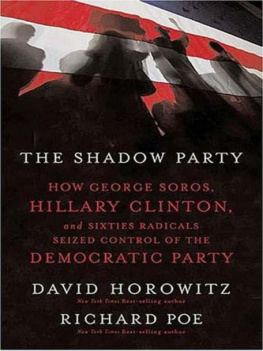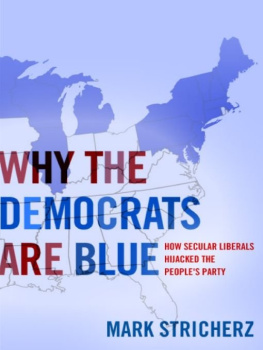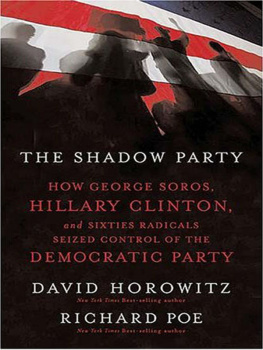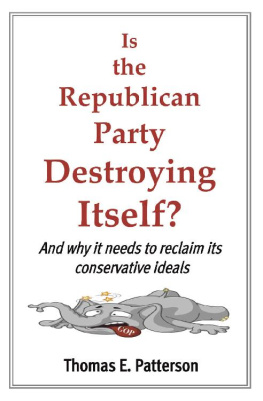THE SHADOW PARTY
THE SHADOW PARTY
HOW GEORGE SOROS,
HILLARY CLINTON,
and SIXTIES RADICALS
SEIZED CONTROL OF THE
DEMOCRATIC PARTY
DAVID HOROWITZ
AND
RICHARD POE

Copyright 2006 by David Horowitz and Richard Poe All rights reserved. No portion of this book may be reproduced, stored in a retrieval system, or transmitted in any form or by any meanselectronic, mechanical, photocopy, recording, scanning, or otherexcept for brief quotations in critical reviews or articles, without the prior written permission of the publisher. Published in Nashville, Tennessee, by Nelson Current, a division of a wholly-owned subsidiary (Nelson Communications, Inc.) of Thomas Nelson, Inc. Nelson Current books may be purchased in bulk for educational, business, fundraising, or sales promotional use. For information, please e-mail SpecialMarkets@ThomasNelson.com. ISBN: 1-59555-0445
Printed in the United States of America
06 07 08 09 10 QW 5 4 3 2 1
To our wives, April Horowitz and Marie Poe,
whose loving support has provided
an isle of peace in the tempest,
and whose counsel has shaped this book
in more ways than anyone will know.
CONTENTS
T he war in Iraq marks a new era in Americas political life. Never previously has one of Americas two major political parties attacked a sitting president and wartime commander-in-chief with the ferocity manifested by leaders of the Democratic Party today. Never before has the country been so divided in the early stages of a war on foreign soil.
Bipartisanship in wartime has been a hallmark of American foreign policy since the Second World War. Republicans displayed it when President Clinton went to war in Bosnia and Kosovo wars conducted without congressional authorization or UN approval, but which Republican leaders nonetheless supported. Such bipartisanship is strikingly absent in Americas war in Iraq. It has been undone by a Democratic leadership committed to more radical goals.
The Democrats movement to the political left is not new. Progressive activists have been carrying out a broad-ranging infiltration of American political and cultural institutions for forty years. Now the effects of that infiltration can be seen in the inability of Americas political leaders to form a united front against a clear military threat from abroad.
This book is about the radical forces which are undermining American unity. It identifies the radical leaders and explains their strategy. These activists are organized in two distinct movements, one exerting pressure from below, the other exerting pressure from above. In a 1957 tract, Czech Communist Party theoretician Jan Kozk explained how a small number of communists managed to gain power in Czechoslovakia through parliamentary maneuvers. The trick was to exert pressure for radical change from two directions simultaneouslyfrom the upper levels of government and from provocateurs in the streets. Kozk called this tactic pressure from above and below.
One way to exert pressure from below, as Kozk explained, was to fill the streets with rioters, strikers and protesters, thus creating the illusion of a widespread clamor for change from the grassroots. Radicals in the government would then exert pressure from above, enacting new laws on the pretext of appeasing the protesters in the streeteven though the protesters (or at least their leaders) were themselves part of the plot. The majority of the people would have no idea what was going on. Squeezed from above and below, most would sink into apathy and despair, believing they were hopelessly outnumbered by the radicals even though they were not. Thus could a radical minority impose its will on a moderate majority, even under a democratic, parliamentary system.
In America today, pressure from belowthe intrusion of street-level radicals into the political processhas already profoundly changed the Democratic Party. This became evident as early as the McGovern campaign of 1972. It has become obvious in recent years that a corresponding pressure from above is now closing the pincer from the opposite direction. This movement from above is spear-headed by forces, both inside and outside the party, situated at the highest levels of political and financial power. The revolution from above involves key figures from the Clinton White House, including Hillary Rodham Clinton and her factotum Harold Ickes, along with Bill Clintons White House chief of staff John Podesta.
The Lenin behind this revolution, however, is a man outside the political process altogether. Financial wizard and political manipulator, George Soros is the architect of a Shadow Party which operates much like a network of holding companies coordinating the disparate branches of this movement, both inside and outside the Democratic Party, and leading them toward the goal of securing state power. Once attained, that power will be used to effect a global transformationeconomic, social and politicala post-Berlin Wall reincarnation of the old radical dream.
In short, this book documents how, through an extraordinary series of political, legal and financial maneuvers, an unlikely network of radical activists and activist billionaires gained de facto control over the Democratic Partys campaign apparatus including both its media air war and its get-out-the-vote ground war, and thus over its electoral future. This party within the party (but also outside the party) has no official name, but, without fully comprehending its scope, some journalists and commentators have dubbed it the Shadow Party, a term we have adopted in writing this book.
The Shadow Party is a network of private organizations that exercises a powerful and hidden influence over the Democratic Party, and through it, over American politics in general. It is not a political party per se, and it works outside of the normal electoral system, in pursuance of goals that are not openly disclosed.
The Shadow Party cannot afford to function as an ordinary political party. That would require making an honest, public appeal to voters, and this it cannot do, for its radical vision would offend most Americans. If Americans understood the intentions of the Shadow Party organizers, they would recoil in revulsion and reject its overtures. For these reasons, the Shadow Party network must proceed by stealth. It must (and does) use secretive, deceptive, and extra-constitutional means to achieve its objectives. It must infiltrate government bureaucracies, corrupt public officials and manipulate the press. And it must conceal who and what it is.
The Shadow Party does not confine its activities to the Democratic Party. If it did, it would be less effective. A number of notable Republicans, among them Senator John McCain, have exchanged political favors with the Shadow Party. But the Democratic Partybecause it is already a party of the Leftis the focus of the Shadow Partys activities and its chosen instrument. The Shadow Party has not yet achieved its goal of federal power, but since the 2004 election, it has attained a degree of control over the Democratic National Committee and the Democratic Party in general, that is nearly complete.
During the 2004 election cycle, the Shadow Partyheaded by a group of leftist billionaireswas able to contribute more than $300 million to the Democrat war chest, and, through its independent media campaigns, to effectively shape the Democrats message. Despite their defeat at the polls, Shadow Party leaders were intoxicated by their achievement. On December 9, 2004, Eli Pariser, who headed the Shadow Party group MoveOn PAC, boasted to his members, Now its our party. We bought it, we own it.
Whom does Pariser mean exactly when he says we? What special interests does he represent? Who bought the Democratic Party in 2004, and what use do they plan to make of it? The following pages provide answers to these questions. They reveal the radical network that now steers the Democratic Party and shapes its policies. They recount the history of this network and describe its players, tactics and goals. These goals are informed by a fundamental hostility to American institutionseven to the idea of Americas sovereignty as a nation.
Next page













